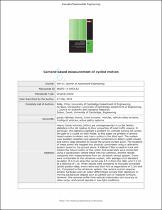JavaScript is disabled for your browser. Some features of this site may not work without it.
- ResearchSpace
- →
- Research Publications/Outputs
- →
- Journal Articles
- →
- View Item
| dc.contributor.author |
Eddy, C

|
|
| dc.contributor.author |
de Saxe, Christopher C

|
|
| dc.contributor.author |
Cebon, D

|
|
| dc.date.accessioned | 2018-08-22T08:38:54Z | |
| dc.date.available | 2018-08-22T08:38:54Z | |
| dc.date.issued | 2018-08 | |
| dc.identifier.citation | Eddy, C., de Saxe, C.C. and Cebon, D. 2018. Camera-based measurement of cyclist motion. Proceedings of the Institution of Mechanical Engineers, Part D: Journal of Automobile Engineering: https://doi.org/10.1177/0954407018789301 | en_US |
| dc.identifier.issn | 2041-2991 | |
| dc.identifier.issn | 0954-4070 | |
| dc.identifier.uri | http://journals.sagepub.com/doi/abs/10.1177/0954407018789301?journalCode=pidb | |
| dc.identifier.uri | https://doi.org/10.1177/0954407018789301 | |
| dc.identifier.uri | http://hdl.handle.net/10204/10375 | |
| dc.description | Due to copyright restrictions, the attached PDF file contains the pre-print version of the published item. For access to the published version, please consult the publisher's website. The definitive version of the work is published at: https://doi.org/10.1177/0954407018789301 | en_US |
| dc.description.abstract | Heavy Goods Vehicles (HGVs) are overrepresented in cyclist fatality statistics in the UK relative to their proportion of total traffic volume. In particular, the statistics highlight a problem for vehicles turning left across the path of a cyclist on their inside. In this paper we present a camera-based system to detect and track cyclists in the blind spot. The system uses boosted classifiers and geometric constraints to detect cyclist wheels, and Canny edge detection to locate the ground contact point. The locations of these points are mapped into physical coordinates using a calibration system based on the ground plane. A Kalman Filter is used to track and predict the future motion of the cyclist. Full-scale tests were conducted using a construction vehicle fitted with two cameras, and the results compared with measurements from an ultrasonic-sensor system. Errors were comparable to the ultrasonic system, with average error standard deviation of 4.3 cm when the cyclist was 1.5 m from the HGV, and 7.1 cm at a distance of 1 m. When results were compared to manually extracted cyclist position data, errors were less than 4 cm at separations of 1.5 m and 1 m. Compared to the ultrasonic system, the camera system requires simpler hardware and can easily differentiate cyclists from stationary or moving background objects such as parked cars or roadside furniture. However, the cameras suffer from reduced robustness and accuracy at close range, and cannot operate in low-light conditions. | en_US |
| dc.language.iso | en | en_US |
| dc.publisher | Camera-based measurement of cyclist motion | en_US |
| dc.relation.ispartofseries | Worklist;21240 | |
| dc.subject | Active safety systems | en_US |
| dc.subject | Cyclist detection | en_US |
| dc.subject | Heavy goods vehicles | en_US |
| dc.subject | Computer vision | en_US |
| dc.subject | Object detection | en_US |
| dc.title | Camera-based measurement of cyclist motion | en_US |
| dc.type | Article | en_US |
| dc.identifier.apacitation | Eddy, C., de Saxe, C. C., & Cebon, D. (2018). Camera-based measurement of cyclist motion. http://hdl.handle.net/10204/10375 | en_ZA |
| dc.identifier.chicagocitation | Eddy, C, Christopher C de Saxe, and D Cebon "Camera-based measurement of cyclist motion." (2018) http://hdl.handle.net/10204/10375 | en_ZA |
| dc.identifier.vancouvercitation | Eddy C, de Saxe CC, Cebon D. Camera-based measurement of cyclist motion. 2018; http://hdl.handle.net/10204/10375. | en_ZA |
| dc.identifier.ris | TY - Article AU - Eddy, C AU - de Saxe, Christopher C AU - Cebon, D AB - Heavy Goods Vehicles (HGVs) are overrepresented in cyclist fatality statistics in the UK relative to their proportion of total traffic volume. In particular, the statistics highlight a problem for vehicles turning left across the path of a cyclist on their inside. In this paper we present a camera-based system to detect and track cyclists in the blind spot. The system uses boosted classifiers and geometric constraints to detect cyclist wheels, and Canny edge detection to locate the ground contact point. The locations of these points are mapped into physical coordinates using a calibration system based on the ground plane. A Kalman Filter is used to track and predict the future motion of the cyclist. Full-scale tests were conducted using a construction vehicle fitted with two cameras, and the results compared with measurements from an ultrasonic-sensor system. Errors were comparable to the ultrasonic system, with average error standard deviation of 4.3 cm when the cyclist was 1.5 m from the HGV, and 7.1 cm at a distance of 1 m. When results were compared to manually extracted cyclist position data, errors were less than 4 cm at separations of 1.5 m and 1 m. Compared to the ultrasonic system, the camera system requires simpler hardware and can easily differentiate cyclists from stationary or moving background objects such as parked cars or roadside furniture. However, the cameras suffer from reduced robustness and accuracy at close range, and cannot operate in low-light conditions. DA - 2018-08 DB - ResearchSpace DP - CSIR KW - Active safety systems KW - Cyclist detection KW - Heavy goods vehicles KW - Computer vision KW - Object detection LK - https://researchspace.csir.co.za PY - 2018 SM - 2041-2991 SM - 0954-4070 T1 - Camera-based measurement of cyclist motion TI - Camera-based measurement of cyclist motion UR - http://hdl.handle.net/10204/10375 ER - | en_ZA |






